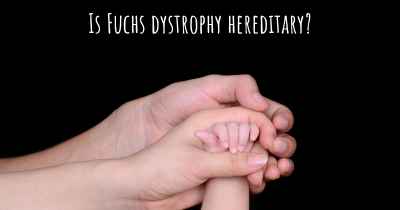What is the history of Fuchs dystrophy?
When was Fuchs dystrophy discovered? What is the story of this discovery? Was it coincidence or not?

Fuchs dystrophy is a progressive eye disease that affects the cornea, the clear front surface of the eye. It is named after Ernst Fuchs, an Austrian ophthalmologist who first described the condition in 1910. Fuchs dystrophy is characterized by the gradual deterioration of the corneal endothelium, the innermost layer of cells responsible for maintaining the cornea's clarity and hydration.
Early Discoveries:
The history of Fuchs dystrophy dates back to the early 20th century when Ernst Fuchs observed a group of patients with a peculiar corneal condition. He noted the presence of small, grayish-white dots on the corneal endothelium, which he termed "guttae." Fuchs also observed that these patients experienced progressive vision loss and corneal edema, leading to the development of what is now known as Fuchs dystrophy.
Advancements in Understanding:
Over the years, further research and advancements in medical technology have shed light on the underlying causes and progression of Fuchs dystrophy. It was discovered that Fuchs dystrophy is a genetic disorder, often inherited in an autosomal dominant pattern. Mutations in certain genes, such as TCF4, have been identified as contributing factors to the development of the disease.
Pathophysiology:
Fuchs dystrophy primarily affects the corneal endothelium, leading to its dysfunction. The corneal endothelium is responsible for maintaining the cornea's transparency by regulating the amount of fluid within the cornea. In Fuchs dystrophy, the endothelial cells gradually degenerate and become less efficient at pumping fluid out of the cornea. This results in the accumulation of excess fluid, causing corneal swelling and clouding.
Clinical Presentation:
Fuchs dystrophy typically manifests in adulthood, usually after the age of 40. The disease is bilateral, affecting both eyes, although the severity may vary between eyes. Initially, individuals may not experience any symptoms, but as the disease progresses, they may notice blurred or hazy vision, especially in the morning. Other common symptoms include sensitivity to light, glare, and the sensation of a foreign body in the eye.
Stages of Fuchs Dystrophy:
Fuchs dystrophy can be classified into different stages based on the severity of corneal involvement:
Stage 1: In the early stage, guttae (small, grayish-white dots) are visible on the corneal endothelium. Vision is usually unaffected at this stage.
Stage 2: As the disease progresses, the cornea becomes increasingly swollen, leading to blurred or hazy vision, particularly in the morning. This stage is often referred to as "guttae with edema."
Stage 3: In this stage, the corneal swelling becomes more pronounced, causing significant vision impairment throughout the day. Patients may experience increased sensitivity to light and glare.
Stage 4: The final stage of Fuchs dystrophy is characterized by severe corneal edema, leading to the formation of blisters on the corneal surface. These blisters, known as bullae, can cause intense pain and further vision deterioration.
Treatment Options:
While there is no cure for Fuchs dystrophy, several treatment options are available to manage the symptoms and slow down the progression of the disease:
Medications: Eye drops or ointments may be prescribed to alleviate symptoms such as corneal swelling and discomfort.
Corneal Transplant: In advanced cases where vision is significantly impaired, a corneal transplant may be recommended. During this procedure, the damaged cornea is replaced with a healthy donor cornea.
Descemet's Stripping Endothelial Keratoplasty (DSEK): This surgical technique involves selectively replacing only the damaged endothelial layer of the cornea, leaving the rest of the cornea intact.
Descemet's Membrane Endothelial Keratoplasty (DMEK): Similar to DSEK, DMEK involves transplanting only the endothelial layer, but with a thinner graft, resulting in faster visual recovery.
Conclusion:
Fuchs dystrophy is a progressive eye disease that affects the corneal endothelium, leading to vision impairment and corneal edema. Although the disease was first described by Ernst Fuchs in 1910, our understanding of its genetic basis and pathophysiology has significantly advanced over the years. While there is no cure, various treatment options are available to manage the symptoms and improve the quality of life for individuals with Fuchs dystrophy.
A provider can diagnose Fuchs' dystrophy during a slit-lamp exam. Other tests that may be done include: Pachymetry -- measures the thickness of the cornea. Specular microscope examination -- allows the provider to look at the thin layer of cells that line the back part of the cornea.
In 1910, Austrian ophthalmologist Ernst Fuchs (1851–1930) first reported 13 cases of central corneal clouding, loss of corneal sensation and the formation of epithelial bullae, which he labeled ‘dystrophia epithelialis corneae’. It was characterized by late onset, slow progression, decreased visual acuity in the morning, lack of inflammation, diffuse corneal opacity, intense centrally, and roughened epithelium with vesicle-like features
Posted May 22, 2017 by Paula 2100
Posted Jun 24, 2018 by Ed 3620








